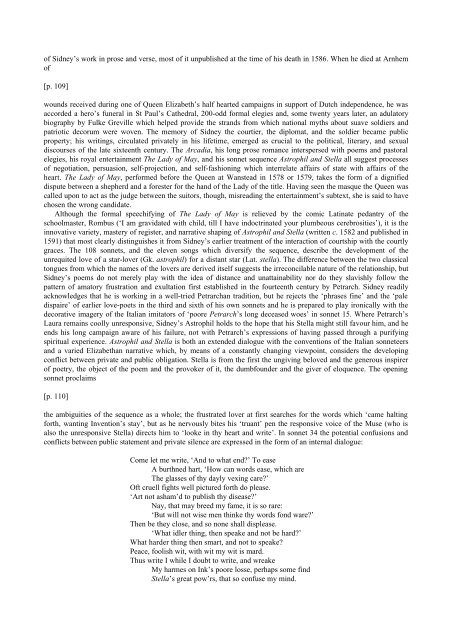THE SHORT OXFORD HISTORY OF ENGLISH LITERATURE
THE SHORT OXFORD HISTORY OF ENGLISH LITERATURE
THE SHORT OXFORD HISTORY OF ENGLISH LITERATURE
You also want an ePaper? Increase the reach of your titles
YUMPU automatically turns print PDFs into web optimized ePapers that Google loves.
of Sidney’s work in prose and verse, most of it unpublished at the time of his death in 1586. When he died at Arnhem<br />
of<br />
[p. 109]<br />
wounds received during one of Queen Elizabeth’s half hearted campaigns in support of Dutch independence, he was<br />
accorded a hero’s funeral in St Paul’s Cathedral, 200-odd formal elegies and, some twenty years later, an adulatory<br />
biography by Fulke Greville which helped provide the strands from which national myths about suave soldiers and<br />
patriotic decorum were woven. The memory of Sidney the courtier, the diplomat, and the soldier became public<br />
property; his writings, circulated privately in his lifetime, emerged as crucial to the political, literary, and sexual<br />
discourses of the late sixteenth century. The Arcadia, his long prose romance interspersed with poems and pastoral<br />
elegies, his royal entertainment The Lady of May, and his sonnet sequence Astrophil and Stella all suggest processes<br />
of negotiation, persuasion, self-projection, and self-fashioning which interrelate affairs of state with affairs of the<br />
heart. The Lady of May, performed before the Queen at Wanstead in 1578 or 1579, takes the form of a dignified<br />
dispute between a shepherd and a forester for the hand of the Lady of the title. Having seen the masque the Queen was<br />
called upon to act as the judge between the suitors, though, misreading the entertainment’s subtext, she is said to have<br />
chosen the wrong candidate.<br />
Although the formal speechifying of The Lady of May is relieved by the comic Latinate pedantry of the<br />
schoolmaster, Rombus (‘I am gravidated with child, till I have indoctrinated your plumbeous cerebrosities’), it is the<br />
innovative variety, mastery of register, and narrative shaping of Astrophil and Stella (written c. 1582 and published in<br />
1591) that most clearly distinguishes it from Sidney’s earlier treatment of the interaction of courtship with the courtly<br />
graces. The 108 sonnets, and the eleven songs which diversify the sequence, describe the development of the<br />
unrequited love of a star-lover (Gk. astrophil) for a distant star (Lat. stella). The difference between the two classical<br />
tongues from which the names of the lovers are derived itself suggests the irreconcilable nature of the relationship, but<br />
Sidney’s poems do not merely play with the idea of distance and unattainability nor do they slavishly follow the<br />
pattern of amatory frustration and exultation first established in the fourteenth century by Petrarch. Sidney readily<br />
acknowledges that he is working in a well-tried Petrarchan tradition, but he rejects the ‘phrases fine’ and the ‘pale<br />
dispaire’ of earlier love-poets in the third and sixth of his own sonnets and he is prepared to play ironically with the<br />
decorative imagery of the Italian imitators of ‘poore Petrarch’s long deceased woes’ in sonnet 15. Where Petrarch’s<br />
Laura remains coolly unresponsive, Sidney’s Astrophil holds to the hope that his Stella might still favour him, and he<br />
ends his long campaign aware of his failure, not with Petrarch’s expressions of having passed through a purifying<br />
spiritual experience. Astrophil and Stella is both an extended dialogue with the conventions of the Italian sonneteers<br />
and a varied Elizabethan narrative which, by means of a constantly changing viewpoint, considers the developing<br />
conflict between private and public obligation. Stella is from the first the ungiving beloved and the generous inspirer<br />
of poetry, the object of the poem and the provoker of it, the dumbfounder and the giver of eloquence. The opening<br />
sonnet proclaims<br />
[p. 110]<br />
the ambiguities of the sequence as a whole; the frustrated lover at first searches for the words which ‘came halting<br />
forth, wanting Invention’s stay’, but as he nervously bites his ‘truant’ pen the responsive voice of the Muse (who is<br />
also the unresponsive Stella) directs him to ‘looke in thy heart and write’. In sonnet 34 the potential confusions and<br />
conflicts between public statement and private silence are expressed in the form of an internal dialogue:<br />
Come let me write, ‘And to what end?’ To ease<br />
A burthned hart, ‘How can words ease, which are<br />
The glasses of thy dayly vexing care?’<br />
Oft cruell fights well pictured forth do please.<br />
‘Art not asham’d to publish thy disease?’<br />
Nay, that may breed my fame, it is so rare:<br />
‘But will not wise men thinke thy words fond ware?’<br />
Then be they close, and so none shall displease.<br />
‘What idler thing, then speake and not be hard?’<br />
What harder thing then smart, and not to speake?<br />
Peace, foolish wit, with wit my wit is mard.<br />
Thus write I while I doubt to write, and wreake<br />
My harmes on Ink’s poore losse, perhaps some find<br />
Stella’s great pow’rs, that so confuse my mind.









